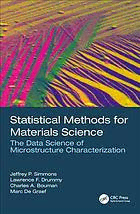Table Of ContentStatistical Methods for
Materials Science
The Data Science of
Microstructure Characterization
Statistical Methods for
Materials Science
The Data Science of Microstructure
Characterization
Jeffrey P. Simmons
Lawrence F. Drummy
Charles A. Bouman
Marc De Graef
Disclaimer
The views presented by Drs. Simmons and Drummy are theirs alone and do not necessarily represent the views of the
Department of Defense, AFRL, or the United States Air Force.
CRC Press
Taylor & Francis Group
6000 Broken Sound Parkway NW, Suite 300
Boca Raton, FL 33487-2742
© 2019 by Taylor & Francis Group, LLC
CRC Press is an imprint of Taylor & Francis Group, an Informa business
No claim to original U.S. Government works
Printed on acid-free paper
Version Date: 20181220
International Standard Book Number-13: 978-1-4987-3820-0 (Hardback)
This book contains information obtained from authentic and highly regarded sources. Reasonable efforts have been
made to publish reliable data and information, but the author and publisher cannot assume responsibility for the validity
of all materials or the consequences of their use. The authors and publishers have attempted to trace the copyright
holders of all material reproduced in this publication and apologize to copyright holders if permission to publish in this
form has not been obtained. If any copyright material has not been acknowledged please write and let us know so we may
rectify in any future reprint.
Except as permitted under U.S. Copyright Law, no part of this book may be reprinted, reproduced, transmitted, or utilized
in any form by any electronic, mechanical, or other means, now known or hereafter invented, including photocopying,
microfilming, and recording, or in any information storage or retrieval system, without written permission from the
publishers.
For permission to photocopy or use material electronically from this work, please access www.copyright.com
(http://www.copyright.com/) or contact the Copyright Clearance Center, Inc. (CCC), 222 Rosewood Drive, Danvers,
MA 01923, 978-750-8400. CCC is a not-for-profit organization that provides licenses and registration for a variety of
users. For organizations that have been granted a photocopy license by the CCC, a separate system of payment has been
arranged.
Trademark Notice: Product or corporate names may be trademarks or registered trademarks, and are used only for
identification and explanation without intent to infringe.
Library of Congress Cataloging-in-Publication Data
Names: Simmons, Jeffrey P., editor. | Bouman, Charles Addison, editor. | De
Graef, Marc, editor. | Drummy, Lawrence F., editor.
Title: Statistical methods for materials science : the data science of
microstructure characterization / edited by Jeffrey P. Simmons, Charles A.
Bouman, Marc De Graef, Lawrence F. Drummy, Jr.
Description: Boca Raton, Florida : CRC Press, [2019] | Includes
bibliographical references.
Identifiers: LCCN 2018029225| ISBN 9781498738200 (hardback : alk. paper) |
ISBN 9781498738217 (ebook adobe reader) | ISBN 9781351647380 (ebook epub)
| ISBN 9781351637879 (ebook mobipocket)
Subjects: LCSH: Materials science--Mathematical models. | Materials
science--Statistical methods.
Classification: LCC TA404.3 .S77 2019 | DDC 620.1/10727--dc23
LC record available at https://lccn.loc.gov/2018029225
Visit the Taylor & Francis Web site at
http://www.taylorandfrancis.com
and the CRC Press Web site at
http://www.crcpress.com
Invert,alwaysinvert.
CarlGustavJacobJacobi
Contents
Preface xvii
AbouttheEditors xix
Contributors xxi
I Introduction 1
1 MaterialsSciencevs.DataScience 3
by Jeffrey P. Simmons, Lawrence F. Drummy, Charles A. Bouman,
and Marc De Graef
II EmergingDataScienceinMicrostructureCharacterization 13
2 EmergingDigitalDataCapabilities 17
byStephenMick
2.1 Introduction 17
2.2 BenefitsofLargeDataVolumes 19
2.3 ChallengesofLargeDataVolumes 21
2.4 EmergingTechniques 22
2.4.1 Multi-InstrumentCoordination 23
2.4.2 UpstreamDataAnalysis 23
2.4.3 DataMining 24
2.4.4 DataCuration 24
2.5 Conclusions 25
3 CulturalDifferences 27
by Mary Comer, Charles A. Bouman, and Jeffrey P. Simmons
3.1 What Makes Modern Image Processing So Modern? 27
3.2 Language of Image Processing 28
3.2.1 NotationalDifferences 28
3.2.1.1 Sets 28
3.2.1.2 OperationsonSets 29
3.2.1.3 ComputationsonSets 31
3.2.2 BayesianProbabilityandImageProcessing 32
3.2.2.1 ModernProbabilityandSets 33
3.2.2.2 FoundationalRulesofModernProbability 33
3.2.2.3 MathematicalConstructs 35
3.2.2.4 BayesianProbabilityinImageProcessing 36
vii
viii Contents
3.3 LanguageofMaterialsScience 39
3.3.1 ThermodynamicPhases 39
3.3.2 FreeEnergies 42
3.4 ConcludingRemarks 46
4 ForwardModeling 47
byMarcDeGraef
4.1 WhatIsForwardModeling? 47
4.1.1 WhatAretheUnknownsinMaterialsCharacterization? 47
4.1.2 ASchematicDescriptionofForwardModeling 49
4.2 ABriefOverviewofElectronScatteringModalities 51
4.3 CaseStudies 52
4.3.1 ElectronBackscatterDiffraction 52
4.3.1.1 BSEMonteCarloSimulations 52
4.3.1.2 DynamicalScatteringSimulations 54
4.3.1.3 DetectorParameters 55
4.3.2 LorentzVectorFieldElectronTomography 56
4.3.2.1 LorentzForwardModel 56
4.3.2.2 ElectronWavePhaseShiftComputations 57
4.3.2.3 ExampleLorentzImageSimulation 61
4.4 Summary 62
5 InverseProblemsandSensing 63
byCharlesA.Bouman
5.1 Introduction 63
5.2 TraditionalApproachestoInversion 63
5.3 BayesianandRegularizedApproachestoInversion 67
5.4 WhyDoesBayesianEstimationWork? 71
5.5 Model-BasedReconstruction 75
5.6 SuccessesandOpportunitiesofBayesianInversion 77
III InverseMethodsforAnalysisofData 81
6 Model-BasedIterativeReconstructionforElectronTomography 85
by Singanallur Venkatakrishnan and Lawrence F. Drummy
6.1 Introduction 85
6.2 Model-Based Iterative Reconstruction 86
6.3 High-Angle Annular Dark-Field STEM Tomography 88
6.3.1 HAADF-STEMForwardModel 88
6.3.2 PriorModel 90
6.3.3 CostFunctionFormulationandOptimizationAlgorithm 91
6.3.4 ExperimentalResults 93
6.3.4.1 SimulatedDataset 93
6.3.4.2 ExperimentalDataset 95
6.4 Bright-FieldElectronTomography 96
6.4.1 BF-TEMForwardModelandCostFunctionFormulation 97
6.4.1.1 GeneralizedHuberFunctionsforAnomalyModeling 98
6.4.1.2 MBIRCostFormulation 100
6.4.2 Results 100
Contents ix
6.4.2.1 SimulatedDataset 101
6.4.2.2 RealDataset 105
6.5 FutureDirections 107
6.6 Conclusion 108
7 Statistical Reconstruction and Heterogeneity Characterization in 3-D Biological
Macromolecular Complexes 111
by Qiu Wang and Peter C. Doerschuk
7.1 Introduction 111
7.2 Statistical 3-D Signal Reconstruction of Macromolecular Complexes 113
7.2.1 Introduction 113
7.2.2 StatisticalModel 113
7.2.3 RelationshipbetweentheMomentsoftheWeightsandtheMomentsof
theElectronScatteringIntensity 115
7.2.4 EstimationCriterion 115
7.2.4.1 qasaFunctionof c¯, V, Q 116
0 0 0
7.2.4.2 c¯,V,andQasaFunctionof c¯, V, Q 116
0 0 0
7.2.4.3 c¯asaFunctionofV,Q, c¯, V, Q 117
0 0 0
7.2.4.4 V asaFunctionofc¯,Q, c¯, V, Q 117
0 0 0
7.2.4.5 QasaFunctionofV,c¯, c¯, V, Q 118
0 0 0
7.2.5 RelationshipwithOtherResults 118
7.2.6 Algorithm 118
7.2.7 Performance 118
7.2.8 Estimation of the a priori Probability Distribution on the Nuisance
Parameters 119
7.2.9 Pre-andPost-Processing 119
7.3 BiologicalExamples 120
7.3.1 FlockHouseVirus(FHV) 120
7.3.2 NudaureliaCapensisω Virus(NωV) 121
7.3.3 Summary 122
7.4 Discussion 123
7.4.1 ChallengesandFutureDirections 123
7.5 Conclusion 125
8 ObjectTrackingthroughImageSequences 127
by Song Wang, Hongkai Yu, Youjie Zhou, Jeffrey P. Simmons, and
Craig Przybyla
8.1 TrackingandKalmanFilters 128
8.2 FiberTrackingUsingtheKalmanFilter 129
8.2.1 FiberDetection 130
8.2.2 ModelParameters 131
8.2.3 MultipleFiberAssociation 131
8.3 TrackingPerformanceEvaluation 133
8.4 TestingDataandSparseSampling 136
8.5 ExperimentResults 137
8.6 OtherTrackingMethods 141
8.7 Summary 141

